Why did Ylvis have a difficult time figuring out what a fox said? This majestic creature was on the animal wheel we all grew up with. It’s not that difficult to figure out! The question that should be asked is, “What does the goat say?” This isn’t a joke. Can you honestly say you know what sound a goat makes? Rumors have pointed to the screams of Taylor Swift being very similar to that of the goat, but harder evidence would help. All I know is this intro would have been much smoother if we had our priorities straight.
I know that most players tend to write tournament reports after a major victory, but I have never really been into writing them that much. Don’t get me wrong, I love reading a good tournament report, but I’m just not that strong of a storyteller. Awkward silences tend to follow most of my stories. So instead of going deep into how the Invitational unfolded, I will do what I do best: talk about the deck I played!
The Origin of Naya Control
I started preparing for the Invitational the moment Brian Braun-Duin eliminated me at Grand Prix Louisville. I put on my thinking cap and went in the tank the whole way back to Roanoke. The first thing I did was compile a list of things that could potentially happen in the metagame.
The most obvious shift would be the popularity of Mono Black Devotion. Todd, BBD, and I put up some very impressive numbers that would force people to respect the deck even if they chose not to the week before. Players would not only pick up the deck without playing much of the format, they would also shift away from strategies like B/W Midrange and Esper Control. Mono Black Devotion would be a big deal at the Invitational.
If Mono Black was going to be a big part of the Invitational metagame, I wanted nothing to do with it. The worst part about playing Mono Black Devotion is the mirror matches. Not only are they not very skill-intensive, but the only way to get an advantage is to play very narrow cards for the mirror. You can have an edge in the mirror if you dedicate a ton of your cards to it. This is not the way I want to play a “good stuff deck.”
The reason decks like this are good is that most of the cards in them overlap in multiple matchups. If you are forced to play a ton of cards for the mirror match to gain an edge, you end up not having enough cards for the other matchups that show up. This can be risky if you are off on reading the metagame.
The other problem that comes up is every deck is gunning for you. There wouldn’t be a single person in the Invitational without a good plan against Mono Black. The numbers of Blood Baron of Vizkopa would be high, and many players would find a specific way to get an advantage.
This is never the place I want to be when preparing for an event. Instead of trying to brute force my way through the rounds, I wanted to sidestep it and play a list of cards that are extremely powerful against the expected decks. Let them cannibalize each other while I find a mix of spells that are good against all of them.
My starting point was Assemble the Legion. This is the card I want to play because of how powerful it is against Mono Black Devotion. I couldn’t really think of a scenario where the card would be bad against them if it resolved in the early turns of a game. How are they ever going to deal with it? They have no removal for it and there hardest-hitting creatures turns into the weakest Abyss of all time.
This is a powerful card to start off a shell with since it has inherent power on its own. You don’t need synergy. You can play a controlling game before this card comes down and simply try to ride it to victory.
Now I had no clue what to put this card in until I looked at Magic Online results. “Well what do we have here?” I said to myself as I looked at a first place deck from Reynad.
Creatures (8)
Planeswalkers (8)
Lands (21)
Spells (23)

This is exactly what I was looking for! Some of the numbers were a bit off from what I would want to play, but for the most part this decklist was genius. I talked to Gerry about the deck and how I thought it validated me as a deck builder by how ingenious it was. He quickly informed me that Reynad posted this deck before Pro Tour Theros and it was more of a lucky called shot than a stroke of genius. Well, whatever it was I was all-in for getting this operational in time for the Invitational.
So what makes this deck such a perfect call for the Invitational? Well for starters, it isn’t synergistic. I talked briefly about this last week, but I’m not a fan of synergistic decks right now. Thoughtseize is the defining card in the metagame, which makes it very difficult to have cards designed to interact with each other. It is much easier to play a card that generates an advantage by itself than to try to get cards to work well together.
The other amazing thing about this deck is that it has removal that can kill Gods. There aren’t a ton of ways to kill Gods, which make people play as if they are invincible. Many players will take the most aggressive lines with their Gods because they always are correct. They never die and are just huge threats that end games quickly. Players will not be prepared to lose their Gods so easily.
This deck also uses Xenegos, the Reveler the way I always wanted to. I constantly compared this card to Huntmaster of the Fells, but could never find a shell that really showed its power as a card advantage engine. I also never tried it in combination with sixteen removal spells.
I ended up spending two whole days on the deck before the Invitational and ended up on this list:
Creatures (7)
Planeswalkers (5)
Lands (26)
Spells (22)

The Selesnya Keyrunes will go down as the last piece of technology Gerry Thompson gave me before he made the trek to Wizards, and they ended up being exactly what this deck wanted. They are not only a threat that can attack a Jace, Architect of Thought, but also allow you to play enough Mountains to chain things to. Turn three happens to also be one of the best time to relocate Prometheus, making it very easy to cast Selesnya Keyrune and Chained to the Rocks on the same turn. It’s not even that bad if an opponent doesn’t play a good target for another turn. The extra mana you get from Selesnya Keyrune also allows for an explosive turn of Chained to the Rocks and Xenegox, the Reveler.
The deck performed much better than I ever imagined. Not only were my results better than expected, but might actually be better than just a flash in the pan. The deck had been doing pretty well on Magic Online, and I didn’t think the metagame would shift enough for it to be obsoleted. So I guess I need to share my experiences with playing the deck!
Sequencing Lands
One of the most important aspects of playing this deck is playing lands in the correct order. I watched a couple people stream the deck this week and was shocked at how poorly they sequenced their lands. It really isn’t any fault of their own since they were just starting to play the deck, but it made me aware of how important it was to cover in my article.
Let’s try a quiz. In all of these examples you have three lands in your hand and four random spells. You are not under any real pressure. What is the first land you should play and why?
Write down your answers for each one, and then we will go over each one individually.
Example #1:
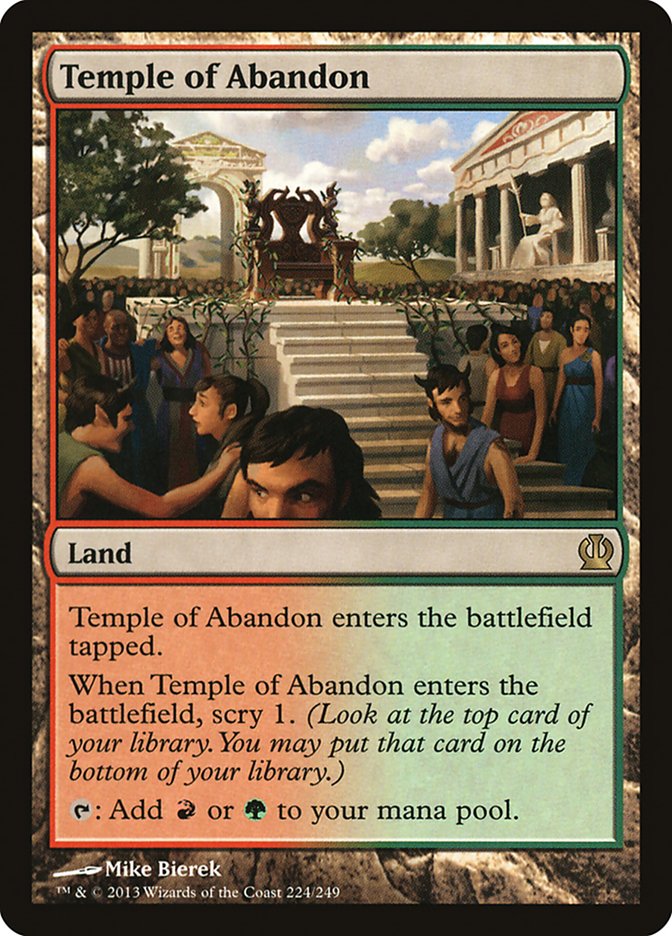
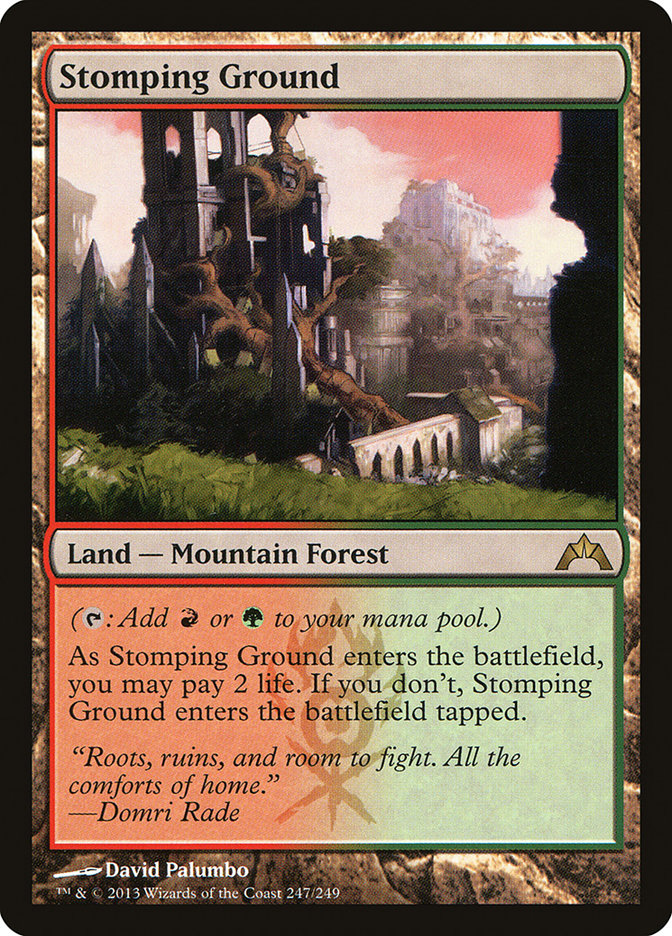
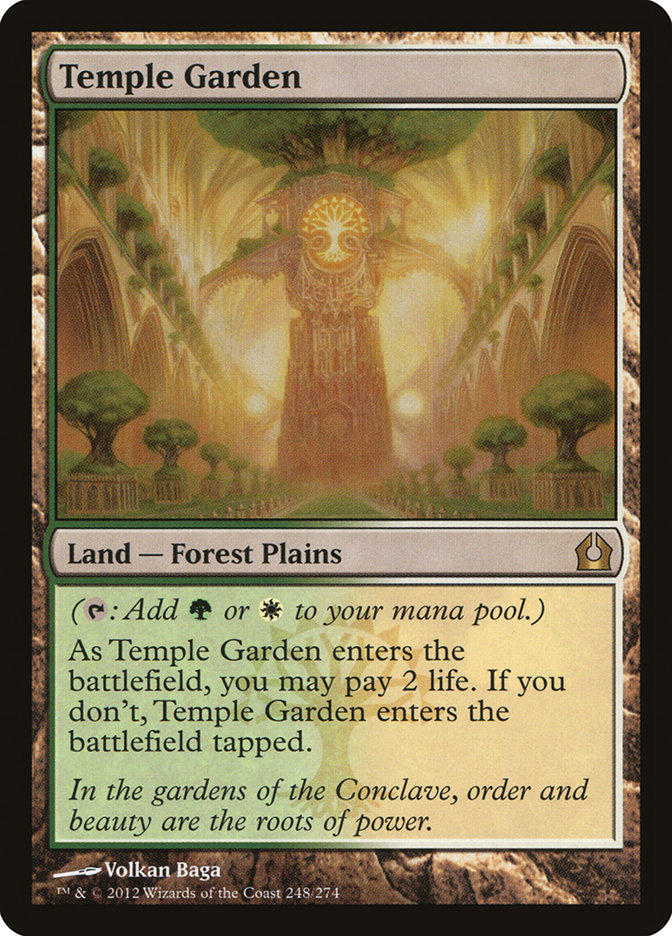
Example #2:
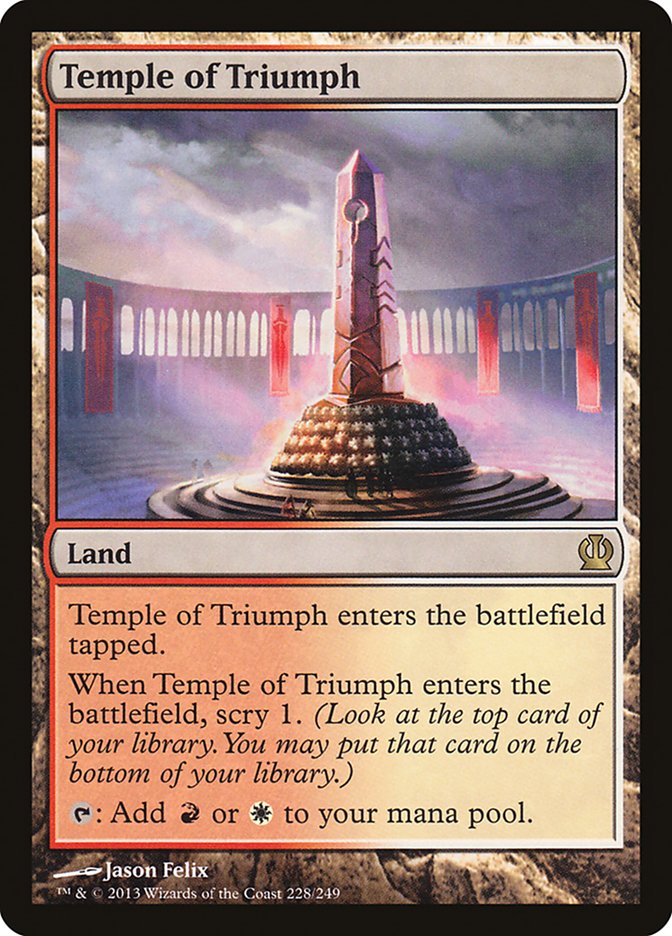


Example #3:

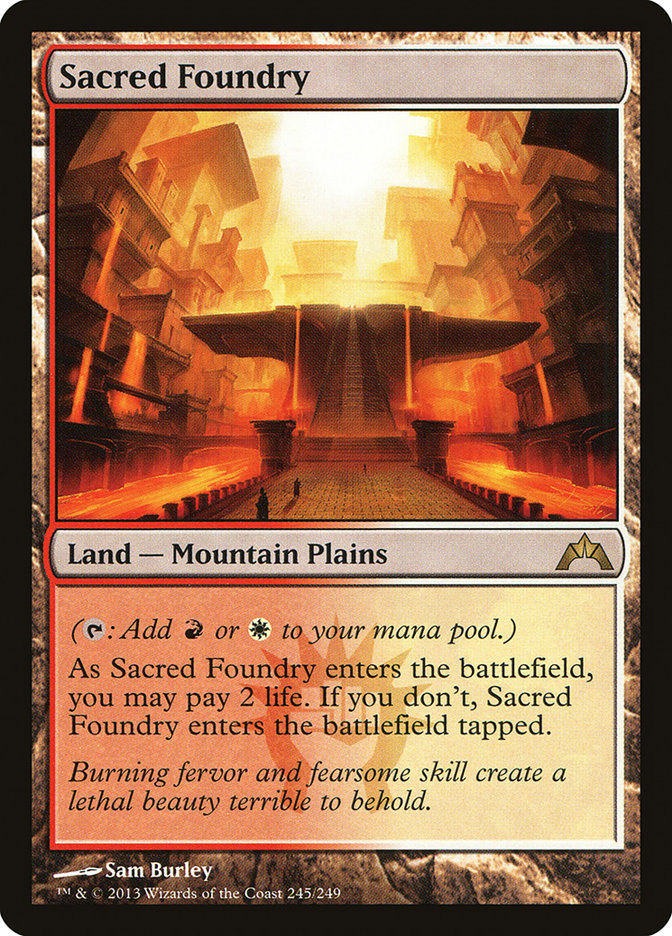

Example #4:



Example #5:



,bR>
Got your answers?
Example #1: Temple Garden
One of the easiest ways to get punished with this deck is to play all of the scry lands first. We don’t really use our mana that much in the early turns and we lose out on manipulation. Being able to manipulate the top card of the library is extremely important in this deck.
The deck also runs 28 sources of mana. We need a fair share of them to function, but we don’t have a good way to utilize extras. It is true that we will need more than three lands to function, but it isn’t worth finding the fourth land on turn one. We can draw a card or two before we decide if finding lands is important. If the first couple draw steps are lands, we know to put one on the bottom. The reason we play Temple Garden first is that it can cast our only one drop without having to take two damage. If our opponent leads on a turn one play that is worth killing, we can simply play our Stomping Ground and cast Chained to the Rocks.
Example #2: Temple of Triumph
Since we have two Temples in our hand, it is more important to play them in the early turns to make sure we can cast a three-drop if we need to. Temple of Triumph is the more important turn-one play for the same reason we chose Temple Garden over Stomping Grounds in the first example.
Example #3: Sacred Foundry
Again, this is because we can cast Chained to the Rocks.
Example #4: Plains
This situation is similar to the others, but is off since it would be the same if we have to play the Mountain on turn two. We do have eight shocklands that are also mountains if we draw them, making Plains the correct land drop.
Example #5: Sacred Foundry
Now I understand that this quickly became very elementary, but I just want to hammer home how important it is to not just play any land on turn one. You have to be thinking about ways to best manipulate your chances of having smooth draws. Playing the lands in the right order with this deck is much more important than with most, so make sure you think about it when you initially pick up the deck.
Know Your Role
The deck is named Naya Control because it sounds awesome, but that doesn’t mean you have to play this deck like a traditional control deck. This deck is more commonly described as a board position deck. You fight for control of the board by killing creatures and getting hard-to-handle permanents onto the battlefield. Sequencing the spells is just as important as sequencing the lands, because you do not want to sacrifice any permanents you don’t have to. Xenegos, the Reveler is a perfect example of a permanent that often looks like a nice way to apply some pressure and gain card advantage, but will oftentimes dies very early if you play it on the fourth turn. Sometimes this is exactly what you want to happen, and sometimes it’s not. You just have to know exactly what you want out of the spells you’re casting.
Games in Standard go much longer than they used to. Sure, there are still some very quick games, but for the most part Standard has slowed down. This means you don’t always have to shove something into play and hope it sticks. It is much more important to play a spell that will give you better positioning later in the game.
This doesn’t mean you don’t have to pull the trigger and go aggressive. This deck has a ton of ways to deal damage, so don’t be afraid to start things off with a Selesnya Charm if an opponent does not look like he is going to be playing a target any time soon. I oftentimes found myself flashing in a Reid Duke token whenever I thought my opponent might be having some engine problems. A quick couple points of damage can force an opponent to play more reactively then they wanted to, letting you slip in a hit or two with Stormbreath Dragon.
The Matchups
Mono Blue Devotion
Game One is all about controlling them in the short term. You need to get a source of damage into play as quickly as possible, which makes it more important to kill things fast. Don’t try to get a ton of value out of an Anger of the Gods. The longer you take to get a board presence, the closer they get to taking over the game with Jace, Architect of Thought. This planeswalker can take over a game very quickly if you do not have something to pressure it with.
Sideboard
-2 Advent of the Wurm
-2 Elspeth, Sun’s Champion
-2 Assemble the Legions
+4 Miscutter Hydra
+2 Last Breath
It gets much easier to pressure them once you have access to Mistcutter Hydra. This creature allows you to have more time to kill all of their creatures since your source of pressure can end a game very quickly.
I like to hold onto my Selesnya Charms more often in sideboarded games due to Mistcutter Hydra. You should kill a Thassa, God of the Sea if one comes on shore, but the best way they can race is to block with Mutavaults in the late game. Simply giving the hydra trample is enough to screw up their combat math.
Mono Black Devotion
This matchup is all about patience. Assemble the Legion is an easy way to win a game, so giving yourself enough turns to draw it is important. I don’t have a problem sitting back and killing every threat they play unless they have an Underworld Connections. That card sure can put a damper on the “kill all of the things” plan.
Naya does have enough ways to present pressure, so you can simply try to get a decent board position set up. One of the easiest sources of pressure is Xenegos, the Reveler. Every Mono Black Devotion opponent will invest an entire turn into playing Hero’s Downfall on this planeswalker. This not only allows you to get in another attack with the Saytr token but also opens a window of opportunity to crack in for four with Stormbreath Dragon. Mono Black Devotion has a tough time holding the ground with creatures since our deck is packed full of efficient removal spells, so they will tend to invest their time into killing every creature you play. The boost in tempo you get from Xenegos, the Reveler might be enough to always be a creature ahead of their removal.
Sideboarding
-4 Loxodon Smiter
-1 Anger of the Gods
+2 Assemble the Legions
+1 Pithing Needle
+2 Wear // Tear
The games get much easier after sideboard (well, at least they did for me at the Invitational). You see, my plan at the Invitational was to be the control player in the matchup. My opponents did not get this memo and would almost always try to attrition me out. This really doesn’t work when they are already sideboarding in a way that caters to my best interests without them even knowing it.
Every Mono Black Devotion opponent I played against last weekend boarded Lifebane Zombie in against me. It was as close to a blank as possible since my entire deck was lacking in the white and green creature department. Not a single card could be taken with this creature, but my opponent had already invested a spell into being aggressive. Sure, they could transition out without breaking a sweat, but there was a very good chance that they had at least one more creature in their hand. What are they going to do, not play it?
The Wear // Tears and Pithing Needle are here to help control Underworld Connections. If they don’t have one active, they can’t really win. You have a ton of Planeswalkers that they need to kill, but they each leave a small army in play, and you have more removal than they do creatures. What tends to happen when you don’t have Assemble the Legions going is you have a token or two from a couple of dead Planeswalkers. This isn’t the biggest issue since the couple of creatures in play can do a ton of work. They will oftentimes have to resort to blocking a Saytr with a Mutavault or even spend a removal spell on it.
Esper Control
This was the matchup I was most scared to play going into the event. The games after sideboard were fine, but Game One was almost always a loss due to the sixteen effectively-dead removal spells in the maindeck. Game One always came down to trying to be aggressive and hoping to stick something that could kill them.
-4 Mizzium Mortars
-4 Chained to the Rocks
-4 Anger of the Gods
-1 Selesnya Charm
+1 Pithing Needle
+4 Mistcutter Hydra
+2 Sunhome Guildmage
+2 Assemble the Legion
+2 Wear // Tear
+2 Ruric Thar, the Unbowed
The games get much easier after sideboarding. You have a decent amount of threats and you should treat them as such. The way to play the matchup is to just keep playing huge threats until your opponent runs out of answers or you run out of threats. Sequencing your threats is completely contextual to what has been going on. If Jace, Architect of Thought is a problem, you should try to kill it with Sunhome Guildmage or Pithing Needle. If your opponent has a ton of counterspells, you should lead with Advent of the Wurm into Ruric Thar, the Unbowed. It is far too complex of a matchup to go into any sort of detail except to say that we are always trying to be aggressive.
Green/Red Devotion
This is one of the more challenging matchups. Not because it is a bad matchup but because there is no room for error. They are a highly explosive deck that can come out of the gates with unbeatable draws. Do not get too greedy with Anger of the Gods. If they are presenting a two-for-one, absolutely take it.
This is another matchup where being proactive helps. Oftentimes there is no better play than a turn-three Loxodon Smiter. Not only does it survive Anger of the Gods, but it also attacks the planeswalkers after you cast it. Unsurprisingly, it is important to have some pressure on Domri Rade and Garruk, Caller of Beasts.
Sideboard
-2 Assemble the Legions
-1 Elspeth, Sun’s Champion
+1 Pithing Needle
+2 Last Breath
I would strongly suggest changing one of the Wear // Tear to a Pithing Needle if this deck is popular in your area. I don’t like boarding in two Pithing Needles in any other matchup since Wear // Tear can be much more powerful at dealing with multiple permanents and can answer a Detention Sphere. I just don’t have any more room for another Pithing Needle unless it is an anti-Underworld Connections slot.
Those same rules still apply after sideboard except their deck is probably worse now. Sideboarding on their side is exactly what you want them to do. They have cards in their sideboard, but none of them help cast a Garruk, Caller of Beasts quicker. They want to be more resilient against you, but the fact of the matter is that the other 56 cards in their deck don’t beat you. It is just the six-mana planeswalker.
Moving Forward
Creatures (12)
Planeswalkers (5)
Lands (18)
Spells (25)

This is the latest version of the deck that I was trying this week. I expect there will be more Esper in the metagame and want to get to my big spells faster. I don’t know if Mono Blue Devotion will continue to see so much play given that it hasn’t had great results lately. I would continue to play the first version if your metagame is filled with fast decks, and would consider switching over to this one if you expect the metagame to be filled with decks like Esper, Mono Black Devotion, or even the mirror. Bramblecrush doesn’t look that bad if everyone has Underworld Connections, Detention Sphere, or Chained to the Rocks.
Next Week
I really want to get back to recording Standard Magic Online videos and will find a lot more time to do so next week. Starting with Pro Tour Theros, I have played a different deck each week and have no clue what you guys really want to see. Please let me know which deck you would like me to break down next week in the comments and I will gladly record some videos of me playing with it.
